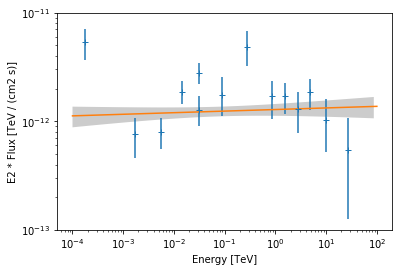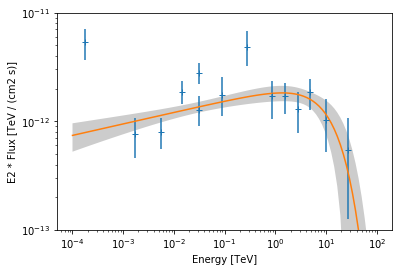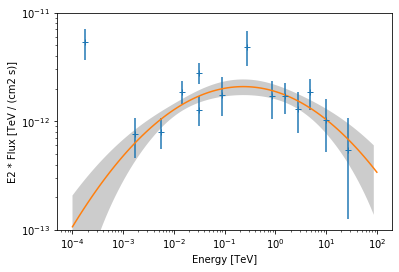This is a fixed-text formatted version of a Jupyter notebook
You can contribute with your own notebooks in this GitHub repository.
Source files: sed_fitting.ipynb | sed_fitting.py
Flux point fitting in Gammapy¶
Introduction¶
In this tutorial we’re going to learn how to fit spectral models to combined Fermi-LAT and IACT flux points.
The central class we’re going to use for this example analysis is:
In addition we will work with the following data classes:
And the following spectral model classes:
Setup¶
Let us start with the usual IPython notebook and Python imports:
[1]:
%matplotlib inline
[2]:
import numpy as np
from astropy import units as u
from gammapy.modeling.models import (
PowerLawSpectralModel,
ExpCutoffPowerLawSpectralModel,
LogParabolaSpectralModel,
SkyModel,
)
from gammapy.spectrum import FluxPointsDataset, FluxPoints
from gammapy.catalog import SOURCE_CATALOGS
from gammapy.modeling import Fit
Load spectral points¶
For this analysis we choose to work with the source ‘HESS J1507-622’ and the associated Fermi-LAT sources ‘3FGL J1506.6-6219’ and ‘3FHL J1507.9-6228e’. We load the source catalogs, and then access source of interest by name:
[3]:
catalog_3fgl = SOURCE_CATALOGS["3fgl"]()
catalog_3fhl = SOURCE_CATALOGS["3fhl"]()
catalog_gammacat = SOURCE_CATALOGS["gamma-cat"]()
[4]:
source_fermi_3fgl = catalog_3fgl["3FGL J1506.6-6219"]
source_fermi_3fhl = catalog_3fhl["3FHL J1507.9-6228e"]
source_gammacat = catalog_gammacat["HESS J1507-622"]
The corresponding flux points data can be accessed with .flux_points attribute:
[5]:
flux_points_gammacat = source_gammacat.flux_points
flux_points_gammacat.table
[5]:
| e_ref | dnde | dnde_errn | dnde_errp |
|---|---|---|---|
| TeV | 1 / (cm2 s TeV) | 1 / (cm2 s TeV) | 1 / (cm2 s TeV) |
| float32 | float32 | float32 | float32 |
| 0.8609 | 2.29119e-12 | 8.70543e-13 | 8.95502e-13 |
| 1.56151 | 6.98172e-13 | 2.20354e-13 | 2.30407e-13 |
| 2.76375 | 1.69062e-13 | 6.7587e-14 | 7.18838e-14 |
| 4.8916 | 7.72925e-14 | 2.40132e-14 | 2.60749e-14 |
| 9.98858 | 1.03253e-14 | 5.06315e-15 | 5.64195e-15 |
| 27.0403 | 7.44987e-16 | 5.72089e-16 | 7.25999e-16 |
In the Fermi-LAT catalogs, integral flux points are given. Currently the flux point fitter only works with differential flux points, so we apply the conversion here.
[6]:
flux_points_3fgl = source_fermi_3fgl.flux_points.to_sed_type(
sed_type="dnde", model=source_fermi_3fgl.spectral_model()
)
flux_points_3fhl = source_fermi_3fhl.flux_points.to_sed_type(
sed_type="dnde", model=source_fermi_3fhl.spectral_model()
)
Finally we stack the flux points into a single gammapy.spectrum.FluxPoints object and drop the upper limit values, because currently we can’t handle them in the fit:
[7]:
# Stack flux point tables
flux_points = FluxPoints.stack(
[flux_points_gammacat, flux_points_3fhl, flux_points_3fgl]
)
t = flux_points.table
t["dnde_err"] = 0.5 * (t["dnde_errn"] + t["dnde_errp"])
# Remove upper limit points, where `dnde_errn = nan`
is_ul = np.isfinite(t["dnde_err"])
flux_points = FluxPoints(t[is_ul])
flux_points
[7]:
FluxPoints(sed_type='dnde', n_points=14)
Power Law Fit¶
First we start with fitting a simple gammapy.modeling.models.PowerLawSpectralModel.
[8]:
pwl = PowerLawSpectralModel(
index=2, amplitude="1e-12 cm-2 s-1 TeV-1", reference="1 TeV"
)
model = SkyModel(spectral_model=pwl)
After creating the model we run the fit by passing the 'flux_points' and 'model' objects:
[9]:
dataset_pwl = FluxPointsDataset(model, flux_points)
fitter = Fit([dataset_pwl])
result_pwl = fitter.run()
And print the result:
[10]:
print(result_pwl)
OptimizeResult
backend : minuit
method : minuit
success : True
message : Optimization terminated successfully.
nfev : 40
total stat : 28.29
[11]:
print(pwl)
PowerLawSpectralModel
name value error unit min max frozen
--------- --------- ----- -------------- --- --- ------
index 1.985e+00 nan nan nan False
amplitude 1.283e-12 nan cm-2 s-1 TeV-1 nan nan False
reference 1.000e+00 nan TeV nan nan True
Finally we plot the data points and the best fit model:
[12]:
ax = flux_points.plot(energy_power=2)
pwl.plot(energy_range=[1e-4, 1e2] * u.TeV, ax=ax, energy_power=2)
# assign covariance for plotting
pwl.parameters.covariance = result_pwl.parameters.covariance
pwl.plot_error(energy_range=[1e-4, 1e2] * u.TeV, ax=ax, energy_power=2)
ax.set_ylim(1e-13, 1e-11);

Exponential Cut-Off Powerlaw Fit¶
Next we fit an gammapy.modeling.models.ExpCutoffPowerLawSpectralModel law to the data.
[13]:
ecpl = ExpCutoffPowerLawSpectralModel(
index=1.8,
amplitude="2e-12 cm-2 s-1 TeV-1",
reference="1 TeV",
lambda_="0.1 TeV-1",
)
model = SkyModel(spectral_model=ecpl)
We run the fitter again by passing the flux points and the model instance:
[14]:
dataset_ecpl = FluxPointsDataset(model, flux_points)
fitter = Fit([dataset_ecpl])
result_ecpl = fitter.run()
print(ecpl)
ExpCutoffPowerLawSpectralModel
name value error unit min max frozen
--------- --------- ----- -------------- --- --- ------
index 1.894e+00 nan nan nan False
amplitude 1.962e-12 nan cm-2 s-1 TeV-1 nan nan False
reference 1.000e+00 nan TeV nan nan True
lambda_ 7.766e-02 nan TeV-1 nan nan False
alpha 1.000e+00 nan nan nan True
We plot the data and best fit model:
[15]:
ax = flux_points.plot(energy_power=2)
ecpl.plot(energy_range=[1e-4, 1e2] * u.TeV, ax=ax, energy_power=2)
# assign covariance for plotting
ecpl.parameters.covariance = result_ecpl.parameters.covariance
ecpl.plot_error(energy_range=[1e-4, 1e2] * u.TeV, ax=ax, energy_power=2)
ax.set_ylim(1e-13, 1e-11)
[15]:
(1e-13, 1e-11)

Log-Parabola Fit¶
Finally we try to fit a gammapy.modeling.models.LogParabolaSpectralModel model:
[16]:
log_parabola = LogParabolaSpectralModel(
alpha=2, amplitude="1e-12 cm-2 s-1 TeV-1", reference="1 TeV", beta=0.1
)
model = SkyModel(spectral_model=log_parabola)
[17]:
dataset_log_parabola = FluxPointsDataset(model, flux_points)
fitter = Fit([dataset_log_parabola])
result_log_parabola = fitter.run()
print(log_parabola)
LogParabolaSpectralModel
name value error unit min max frozen
--------- --------- ----- -------------- --- --- ------
amplitude 1.877e-12 nan cm-2 s-1 TeV-1 nan nan False
reference 1.000e+00 nan TeV nan nan True
alpha 2.144e+00 nan nan nan False
beta 4.936e-02 nan nan nan False
[18]:
ax = flux_points.plot(energy_power=2)
log_parabola.plot(energy_range=[1e-4, 1e2] * u.TeV, ax=ax, energy_power=2)
# assign covariance for plotting
log_parabola.parameters.covariance = result_log_parabola.parameters.covariance
log_parabola.plot_error(
energy_range=[1e-4, 1e2] * u.TeV, ax=ax, energy_power=2
)
ax.set_ylim(1e-13, 1e-11);

Exercises¶
Fit a
gammapy.modeling.models.PowerLaw2SpectralModelandgammapy.modeling.models.ExpCutoffPowerLaw3FGLSpectralModelto the same data.Fit a
gammapy.modeling.models.ExpCutoffPowerLawSpectralModelmodel to Vela X (‘HESS J0835-455’) only and check if the best fit values correspond to the values given in the Gammacat catalog
What next?¶
This was an introduction to SED fitting in Gammapy.
If you would like to learn how to perform a full Poisson maximum likelihood spectral fit, please check out the spectrum analysis tutorial.
To learn more about other parts of Gammapy (e.g. Fermi-LAT and TeV data analysis), check out the other tutorial notebooks.
To see what’s available in Gammapy, browse the Gammapy docs or use the full-text search.
If you have any questions, ask on the mailing list .
[ ]: